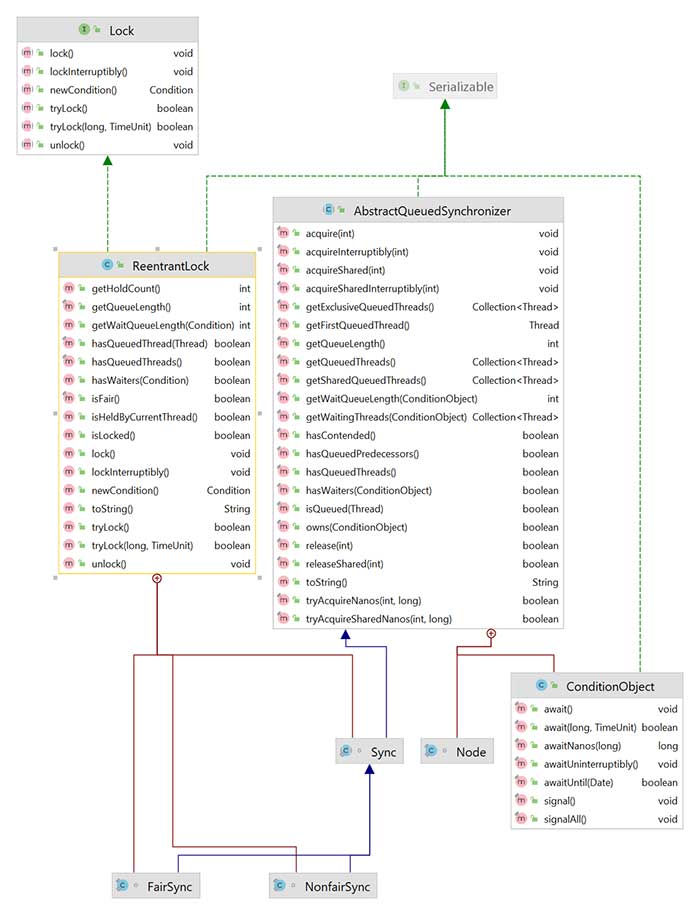1. 介绍
结合上面的ReentrantLock类图,ReentrantLock实现了Lock接口,它的内部类Sync继承自AQS,绝大部分使用AQS的子类需要自定义的方法存在Sync中。而ReentrantLock有公平与非公平的区别,即'是否先阻塞就先获取资源',它的主要实现就是FairSync与NonfairSync,后面会从源码角度看看它们的区别。
2. 源码剖析
Sync是ReentrantLock控制同步的基础。它的子类分为了公平与非公平。使用AQS的state代表获取锁的数量
abstract static class Sync extends AbstractQueuedSynchronizer {
private static final long serialVersionUID = -5179523762034025860L;
/**
* Performs {@link Lock#lock}. The main reason for subclassing
* is to allow fast path for nonfair version.
*/
abstract void lock();
...
}
我们可以看出内部类Sync是一个抽象类,继承它的子类(FairSync与NonfairSync)需要实现抽象方法lock。
下面我们先从非公平锁的角度来看看获取资源与释放资源的原理
故事就从就两个变量开始:
// 获取一个非公平的独占锁
/**
* public ReentrantLock() {
* sync = new ReentrantLock.NonfairSync();
* }
*/
private Lock lock = new ReentrantLock();
// 获取条件变量
private Condition condition = lock.newCondition();
2.1 上锁(获取资源)
lock.lock()
public void lock() {
sync.lock();
}
static final class NonfairSync extends Sync {
private static final long serialVersionUID = 7316153563782823691L;
// 获取资源
final void lock() {
// 若此时没有线程获取到资源,直接设置当前线程独占访问资源。
if (compareAndSetState(0, 1))
setExclusiveOwnerThread(Thread.currentThread());
else
// AQS的方法
acquire(1);
}
protected final boolean tryAcquire(int acquires) {
// 实现在父类Sync中
return nonfairTryAcquire(acquires);
}
}
AQS的acquire
public final void acquire(int arg) {
if (!tryAcquire(arg) &&
acquireQueued(addWaiter(Node.EXCLUSIVE), arg))
selfInterrupt();
}
// Sync实现的非公平的tryAcquire
final boolean nonfairTryAcquire(int acquires) {
final Thread current = Thread.currentThread();
int c = getState();
// 此时若没有线程获取到资源,当前线程就直接占用该资源
if (c == 0) {
if (compareAndSetState(0, acquires)) {
setExclusiveOwnerThread(current);
return true;
}
}
// 若当前线程已经占用了该资源,可以再次获取该资源 ->这个行为就是可重入锁的支撑
else if (current == getExclusiveOwnerThread()) {
int nextc = c + acquires;
if (nextc < 0) // overflow
throw new Error("Maximum lock count exceeded");
setState(nextc);
return true;
}
return false;
}
尝试获取资源的过程是非常简单的,这里再贴一下acquire的流程
2.2 释放资源
lock.unlock();
public void unlock() {
// AQS的方法
sync.release(1);
}
AQS的release
public final boolean release(int arg) {
if (tryRelease(arg)) {
Node h = head;
if (h != null && h.waitStatus != 0)
unparkSuccessor(h);
return true;
}
return false;
}
release的流程已经剖析过了,接下来看看tryRelease的实现
protected final boolean tryRelease(int releases) {
int c = getState() - releases;
// 这里可以看出若没有持有锁,就释放资源,就会报错
if (Thread.currentThread() != getExclusiveOwnerThread())
throw new IllegalMonitorStateException();
boolean free = false;
if (c == 0) {
free = true;
setExclusiveOwnerThread(null);
}
setState(c);
return free;
}
tryRelease的实现也很简单,这里再贴一下release的流程图
2.3 公平锁与非公平锁的区别
公平锁与非公平锁,即'是否先阻塞就先获取资源', ReentrantLock中公平与否的控制就在tryAcquire中。下面我们看看,公平锁的tryAcquire
static final class FairSync extends Sync {
private static final long serialVersionUID = -3000897897090466540L;
final void lock() {
acquire(1);
}
protected final boolean tryAcquire(int acquires) {
final Thread current = Thread.currentThread();
int c = getState();
if (c == 0) {
// (2.3.1)
// sync queue中是否存在前驱结点
if (!hasQueuedPredecessors() &&
compareAndSetState(0, acquires)) {
setExclusiveOwnerThread(current);
return true;
}
}
else if (current == getExclusiveOwnerThread()) {
int nextc = c + acquires;
if (nextc < 0)
throw new Error("Maximum lock count exceeded");
setState(nextc);
return true;
}
return false;
}
}
区别在代码(2.3.1)
hasQueuedPredecessors
判断当前线程的前面有无其他线程排队;若当前线程在队列头部或者队列为空返回false
public final boolean hasQueuedPredecessors() {
// The correctness of this depends on head being initialized
// before tail and on head.next being accurate if the current
// thread is first in queue.
Node t = tail; // Read fields in reverse initialization order
Node h = head;
Node s;
return h != t &&
((s = h.next) == null || s.thread != Thread.currentThread());
}
结合下面的入队代码(enq), 我们分析hasQueuedPredecessors为true的情况:
1.h != t ,表示此时queue不为空; (s = h.next) == null, 表示另一个结点已经运行了下面的步骤(2),还没来得及运行步骤(3)。简言之,就是B线程想要获取锁的同时,A线程获取锁失败刚好在入队(B入队的同时,之前占有的资源的线程,刚好释放资源)
2.h != t 且 (s = h.next) != null,表示此时至少有一个结点在sync queue中;s.thread != Thread.currentThread(),这个情况比较复杂,设想一下有这三个结点 A -> B C, A此时获取到资源,而B此时因为获取资源失败正在sync queue阻塞,C还没有获取资源(还没有执行tryAcquire)。
时刻一:A释放资源成功后(执行tryRelease成功),B此时还没有成功获取资源(C执行s = h.next时,B还在sync queue中且是老二)
时刻二: C此时执行hasQueuedPredecessors,s.thread != Thread.currentThread()成立,此时s.thread表示的是B
private Node enq(final Node node) {
for (;;) {
Node t = tail;
if (t == null) { // Must initialize
if (compareAndSetHead(new Node())) // (1) 第一次初始化
tail = head;
} else {
node.prev = t;
if (compareAndSetTail(t, node)) { // (2) 设置queue的tail
t.next = node; // (3)
return t;
}
}
}
}
Note that 1. because cancellations due to interrupts and timeouts may occur at any time, a true return does not guarantee that some other thread will acquire before the current thread(虚假true). 2. Likewise, it is possible for another thread to win a race to enqueue after this method has returned false, due to the queue being empty(虚假false).
这位大佬对hasQueuedPredecessors进行详细的分析,他文中解释了虚假true以及虚假false。我这里简单解释一下:
1.虚假true, 当两个线程都执行tryAcquire,都执行到hasQueuedPredecessors,都返回true,但是只有一个线程执行compareAndSetState(0, acquires)成功
2.虚假false,当一个线程A执行doAcquireInterruptibly,发生了中断,还没有清除掉该结点时;此时,线程B执行hasQueuedPredecessors时,返回true
以上就是浅谈JAVA并发之ReentrantLock的详细内容,更多关于JAVA并发之ReentrantLock的资料请关注脚本之家其它相关文章!


